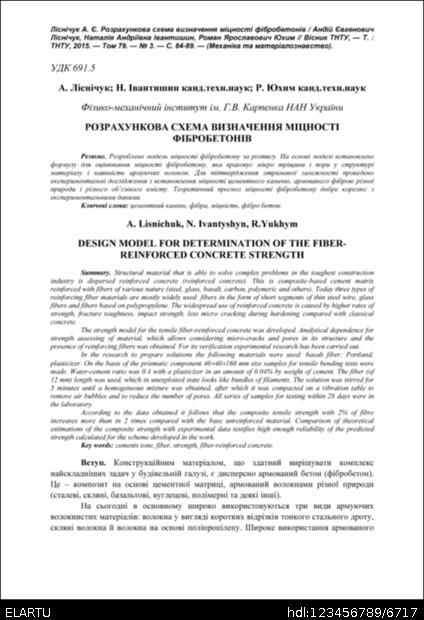Моля, използвайте този идентификатор за цитиране или линк към този публикация:
http://elartu.tntu.edu.ua/handle/123456789/6717

| Заглавие: | Розрахункова схема визначення міцності фібробетонів |
| Други Заглавия: | Design model for determination of the fiber-reinforced concrete strength |
| Автори: | Ліснічук, Андій Євгенович Івантишин, Наталія Андріївна Юхим, Роман Ярославович Lisnichuk, A. Ivantyshyn, N. Yukhym, R. |
| Bibliographic description (Ukraine): | Ліснічук А. Є. Розрахункова схема визначення міцності фібробетонів / Андій Євгенович Ліснічук, Наталія Андріївна Івантишин, Роман Ярославович Юхим // Вісник ТНТУ, — Т. : ТНТУ, 2015 — Том 79. — № 3. — С. 84-89. — (Механіка та матеріалознавство). |
| Bibliographic description (International): | Lisnichuk A., Ivantyshyn N., Yukhym R. (2015) Rozrakhunkova skhema vyznachennia mitsnosti fibrobetoniv [Design model for determination of the fiber-reinforced concrete strength]. Bulletin of TNTU (Tern.), vol. 79, no 3, pp. 84-89 [in Ukrainian]. |
| Is part of: | Вісник Тернопільського національного технічного університету Bulletin of Ternopil National Technical University |
| Дата на Публикуване: | 20-Окт-2015 |
| Submitted date: | 25-Сеп-2015 |
| Date of entry: | 24-Дек-2015 |
| Издател: | ТНТУ TNTU |
| Place of the edition/event: | Україна, Тернопіль Ukraine, Ternopil |
| UDC: | 691.5 |
| Ключови Думи: | цементний камінь фібра міцність фібро бетон cements tone fiber strength fiber-reinforced concrete |
| Page range: | 84-89 |
| Резюме: | Розроблено модель міцності фібробетону за розтягу. На основі моделі встановлено формулу для оцінювання міцності фібробетону, яка враховує мікро тріщини і пори у структурі матеріалу і наявність армуючих волокон. Для підтвердження отриманої залежності проведено експериментальні дослідження з встановлення міцності цементного каменю, армованого фіброю різної природи і різного об’ємного вмісту. Теоретичний прогноз міцності фібробетону добре корелює з експериментальними даними. Structural material that is able to solve complex problems in the toughest construction industry is dispersed reinforced concrete (reinforced concrete). This is composite-based cement matrix reinforced with fibers of various nature (steel, glass, basalt, carbon, polymeric and others). Today three types of reinforcing fiber materials are mostly widely used: fibers in the form of short segments of thin steel wire, glass fibers and fibers based on polypropylene. The widespread use of reinforced concrete is caused by higher rates of strength, fracture toughness, impact strength, less micro cracking during hardening compared with classical concrete. The strength model for the tensile fiber-reinforced concrete was developed. Analytical dependence for strength assessing of material, which allows considering micro-cracks and pores in its structure and the presence of reinforcing fibers was obtained. For its verification experimental research has been carried out. In the research to prepare solutions the following materials were used: basalt fiber; Portland; plasticizer. On the basis of the prismatic component 40x0x160 mm size samples for tensile bending tests were made. Water-cement ratio was 0.4 with a plasticizer in an amount of 0.04% by weight of cement. The fiber (of 12 mm) length was used, which in unexploited state looks like bundles of filaments. The solution was stirred for 5 minutes until a homogeneous mixture was obtained, after which it was compacted on a vibration table to remove air bubbles and to reduce the number of pores. All series of samples for testing within 28 days were in the laboratory. According to the data obtained it follows that the composite tensile strength with 2% of fibre increases more than in 2 times compared with the base unreinforced material. Comparison of theoretical estimations of the composite strength with experimental data testifies high enough reliability of the predicted strength calculated for the scheme developed in the work. |
| URI: | http://elartu.tntu.edu.ua/handle/123456789/6717 |
| ISSN: | 1727-7108 |
| Copyright owner: | © Вісник Тернопільського національного технічного університету, 2015 |
| References (Ukraine): | 1. Panasyuk, V.V. Injection Technologies for Repair of Damaged Concrete Structures [Тext] / V.V. Panasyuk, V.I.Marukha, V.P.Sylovanyuk // Springer. – 2014. – 230 p. 2. Витвицький, П.М. Пружнопластична рівновага пластинки з періодичною системою щілин [Текст] / П.М.Витвицький // Доп. АН УРСР. Сер. А. – 1970. – № 6. – С. 524 – 527. 3. Черепанов, Г.П. Механика хрупкого разрушения [Текст] / Г.П. Черепанов. – М. Наука.: 1977. – 640 с. 4. Kelly, A. Fiberstrengthened materials [Тext] / A. Kelly, W. Tyson // High-strength materials. – New York. – 1965. – № 6. – P. 578 – 600. 5. Рабинович, Ф.Н. Композиты на основе дисперсно армированных бетонов. Вопросы теории и проектирования, технологии, конструкции: монография [Текст] / Ф.Н. Рабинович. – М.: Издательство АВС, 2004. – 560 с. |
| References (International): | 1. Panasyuk, V.V. Injection Technologies for Repair of Damaged Concrete Structures [Text], V.V. Panasyuk, V.I.Marukha, V.P.Sylovanyuk, Springer, 2014, 230 p. 2. Vytvytskyi, P.M. Pruzhnoplastychna rivnovaha plastynky z periodychnoiu systemoiu shchilyn [Text], P.M.Vytvytskyi, Dop. AN URSR. Ser. A, 1970, No 6, P. 524 – 527. 3. Cherepanov, H.P. Mekhanika khrupkoho razrusheniia [Text], H.P. Cherepanov, M. Nauka., 1977, 640 p. 4. Kelly, A. Fiberstrengthened materials [Text], A. Kelly, W. Tyson, High-strength materials, New York, 1965, No 6, P. 578 – 600. 5. Rabinovich, F.N. Kompozity na osnove dispersno armirovannykh betonov. Voprosy teorii i proektirovaniia, tekhnolohii, konstruktsii: monohrafiia [Text], F.N. Rabinovich, M., Izdatelstvo AVS, 2004, 560 p. |
| Content type: | Article |
| Показва се в Колекции: | Вісник ТНТУ, 2015, № 3 (79) |
Файлове в Този Публикация:
| Файл | Описание | Размер | Формат | |
|---|---|---|---|---|
| TNTUB_2015v79n3_Lisnichuk_A-Design_model_for_determination_84-89.pdf | 314,06 kB | Adobe PDF | Изглед/Отваряне | |
| TNTUB_2015v79n3_Lisnichuk_A-Design_model_for_determination_84-89.djvu | 267,47 kB | DjVu | Изглед/Отваряне | |
| TNTUB_2015v79n3_Lisnichuk_A-Design_model_for_determination_84-89__COVER.png | 495,36 kB | image/png | Изглед/Отваряне |
Публикацияте в DSpace са защитени с авторско право, с всички права запазени, освен ако не е указно друго.